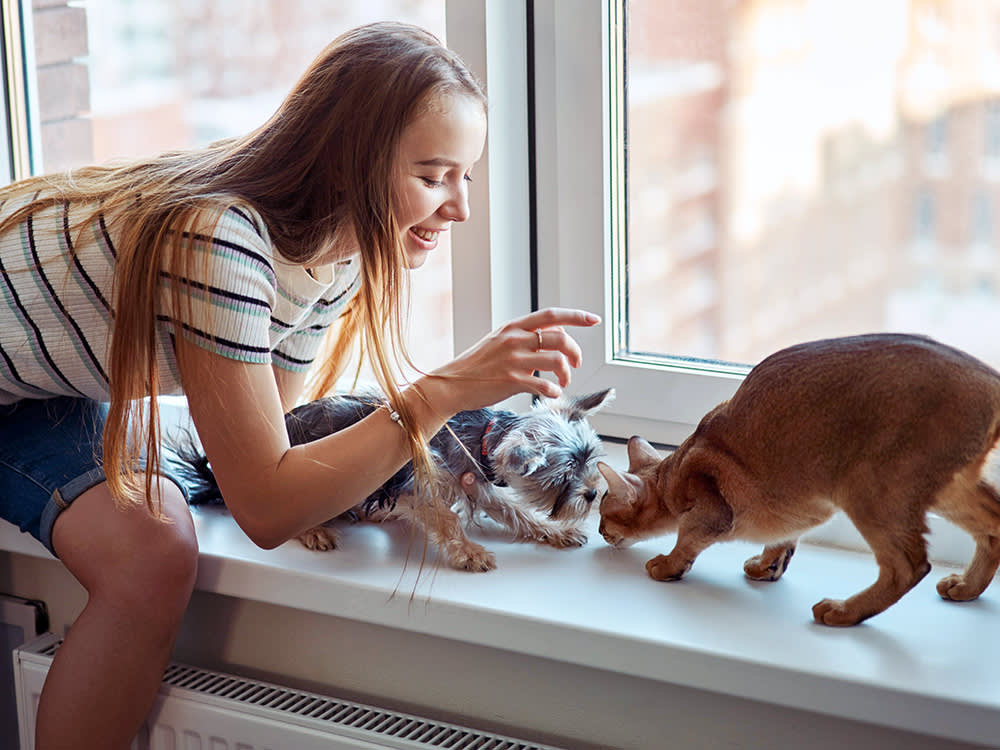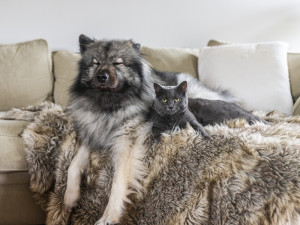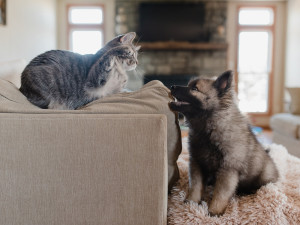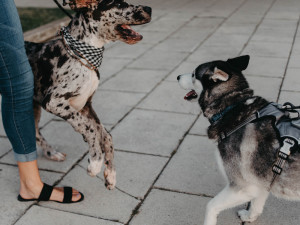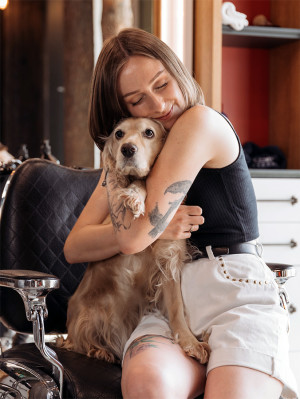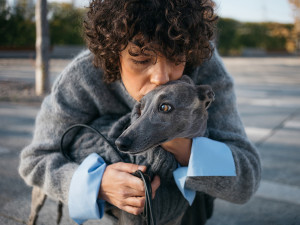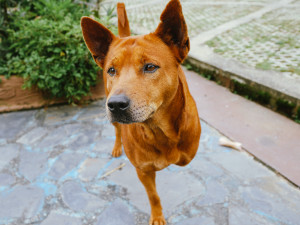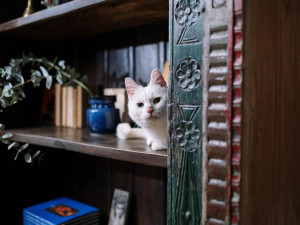Have a Cat But Want a Dog, Too? Here’s How to Make It Work
Just a few things to keep in mind so everything goes smoothly as you all get adjusted
So, you have a cat. But you’ve been looking at pictures of available dogs online like it’s your second job, and by now your cat has noticed all that scrolling. It’s glaringly obvious that you want to add a dog to your family – but with a cat in the house, can you?
Hasn’t every cartoon we’ve watched since childhood taught us that dogs and cats are basically sworn enemies? Slow down, and take a deep breath. While adding a dog to your cat-only family can be a challenge, it’s definitely possible. In fact, many dogs and cats get along and even become friendly with each other, if not the best of buddies. You can do this.
Of course, there are some things you’ll want to consider before you go all in on the hybrid dog/cat parent lifestyle. And, remember: another pet in your family means another pet who needs healthcare, so definitely make sure you sign that pup up for pet insurance pronto.
You also may need to adopt a more active lifestyle than you had with your cat. Get ready for daily walks and playing games like fetch. You might even want to rearrange your house to ensure every member of your family, four-legged or two-legged, is comfortable, and to protect your most valuable possessions from the destructive impulses of two animals.
Adopting any pet comes with its challenges (though all more than worth it). If adding to your pet family is one of your 2024 goals, a little persistence and patience can go a long way in helping your cat co-exist with the dog of your dreams, and ensuring both your pets feel loved.
How are dogs and cats different?
Cats and dogs tend to be considered polar opposites, and not without good reason. Dogs are more domestic and loyal, eager to snuggle up to their favourite human, while cats are known as more independent. So, what are the chances you can get these two very different species to get along?
The best thing you can do for your pets is to understand their personalities and the way they view the world. While every animal is different, in general, dogs tend to be more social and playful, happy to be a part of your daily routine. This is because dogs are pack animals and thrive in families. They will want to hang out with you, engage in a rousing game of fetch, and basically never be separated from you if they can help it.
Your cat, meanwhile, might want a little more time to themselves (read: not all cats!). They may disappear for hours at a time and only show up when they’re in need of a snack or some head scratches. While you and your dog are snoozing at night, your cat may get a burst of energy and run around the house for some solitary playtime. They may be a little more aggressive, slapping or hissing at unfamiliar things, like… your new dog.
But that doesn’t mean your cat can’t learn to tolerate and even like a new member of the family. You just have to be patient and take time to understand your individual pet’s disposition so you can meet them where they are.
For example, you may end up with a cat who is more outgoing and eager to greet anyone who visits, or a dog who is anxious about new situations and people and would prefer to be left alone. Just like people, every animal has their own personality, and it’s important to understand your pet’s demeanour so you can best meet their needs.
Take things one step at a time
While you may have visions of your cat and future dog snuggling up on the couch or playing together, it’s far more likely that both animals will be a bit hesitant around each other at first. That’s why it’s important to take things very slowly and give your cat time to get used to your new dog, and vice versa.
“Change can be stressful for cats, so be sure to keep things as stable and consistent as you can,” says Dr Mikel Delgadoopens in new tab, certified cat behaviour consultant. “Provide them with a regular routine of attention and play… I’ve seen plenty of cats become best buds with a dog when the introduction is done carefully and slowly!”
Step 1: Prepare your home (and your cat)
Before you ever bring a dog into the house, take some time to rearrange the layout so your cat has plenty of space to retreat and feel safe. Make sure the litter box and cat food are in a place where the dog can’t reach them and take a bite (yes, some dogs try to eat cat poo).
Provide plenty of spots where your cat can jump up to safety if they choose and escape an energetic and curious pup. This can include tall cat trees or wall pieces for your cat to climb on, allowing them to watch the dog from a distance and flee the room if they’ve had enough.
“Cats need to feel safe in their environment, so a dog-free room or wing is important, says Dr Delgado. “You can use a baby gate with a cat-sized opening or lift a baby gate just enough that your cat can squeeze under but your dog can’t. In addition, the main area of your home where you expect both pets to eventually co-exist peacefully should also have lots of vertical spaces like cat trees and shelving that allow your cat to navigate and get to know the dog from a distance – at least until they (hopefully) become friends.”
Step 2: Choose the right dog for your family
While it’s easy to fall for the first adorable puppy you see, it’s important that you take the time to find a dog whose personality fits well with your cat and your lifestyle. Look for a dog who has had experience living with cats in the past or has at least done well with cats in the shelter or foster home, but keep in mind that one experience is no guarantee that a dog will like every cat they meet. And even if your cat has done well with a dog in the past, they may not like the new addition to the family.
“There’s no ‘dog test’ to really say that a cat will get along with any dog,” says Dr Delgado. “Each animal has their own personality and feelings about other animals. Just because a cat liked one dog in the past does not mean they will greet every dog with open arms. However, one bad experience with a dog can have a serious impact on whether that cat will accept a dog in the future. That is why it is so important to go slowly and help each pet make positive associations with the other.”
Do your best to match your new dog’s personality with your cat’s. For example, if your cat is older and low energy, you may want to adopt a dog with a calmer personality because a high-energy dog may drive your cat up the wall – literally.
Step 3: Start with scent
Before your dog and cat ever meet face-to-face, try introducing their scents to one another.
“I recommend starting by getting them used to each other’s scent by exchanging bedding, letting each pet explore the other’s bedding at their own pace,” says Dr Delgado. “If they seem OK with that, you can move forward to giving them visual access to one another.”
Each pet can separately sniff the other without seeing them, giving them time to get used to one another’s presence and (hopefully) making their first actual meeting less stressful for all involved. And don’t forget to reward positive behaviour, Dr Delgado emphasises.
“I recommend making sure each pet is having a positive experience when they are near one another, such as playing with a toy, getting highly rewarding treats, or performing tricks for treats.”
Step 4: Introduce both pets in a controlled environment
When your pets finally meet face-to-face, make sure your dog is on the lead and both animals are calm – or as calm as they can be. You may even want to have an extra barrier between your pets, like that baby gate. Choose a meeting space where your cat has places to escape to higher ground, and make sure to reward your dog and your cat with praise and treats for calm behaviour. Continue introducing the two pets with your dog on a lead for several days, and when you’re away, always make sure the dog is in a crate, pen, or separate room where they can’t reach the cat without supervision.
“Many people make the mistake of trying to get their pets closer and closer to the barrier (usually with food) to where they are both eating a few inches from each other with just the gate in between,” says Naomi Rotenberg, cat and dog trainer and owner of Praiseworthy Petsopens in new tab. “Most likely, that isn’t an interaction that you would want them to have when the barrier is no longer there. I prefer keeping a few feet buffer between the animals while they are eating if you are doing controlled interactions.”
Step 5: Try supervised interactions
Once your dog and cat have met each other for about a week with no negative interactions (that is, no attempted attacks, hissing, or growling), try an unleashed meeting. Stay close and keep an eye on both animals so you can quickly separate them if things get heated. Keep rewarding your dog and cat both for remaining calm and watch for any hints of aggression, stress or tension.
If supervised interactions continue to go well, you can start leaving your dog and cat alone together unsupervised for brief periods of time. Start with just a few minutes, like a walk to the mailbox, and work your way up to longer unsupervised meetings. Before you know it, your two pets will be casually chilling in the same space (which is way more exciting than it sounds).
Watch for particular body language when doing the intro
Any time your cat and the new dog interact, it’s important to pay close attention to any signs that either animal is growing overly stressed or aggressive. Here are a few key signs to look out for:
Your dog is really focused on your cat. This could indicate that their predatory instincts are kicking in and may be the first sign of a lunge or attack. Recall your dog and reward them with treats when they come. If recall doesn’t work, separate the two animals.
Your cat’s habits (eating, drinking, litter box use) change. If these habits don’t go back to normal in a few days, your cat may be experiencing stress or anxiety, and the new dog could be the cause.
Either your cat or dog acts aggressively when the other pet is calm. If either animal acts out in aggression without being provoked, they may not be friendly towards the other species, and it may be time to consider bringing in a professional for training.
“When an animal seems stiff, hyper-focused, or ‘stuck’ on the other for more than a few seconds, and they don’t snap themselves out of it, you need to separate them, at least for a little bit,” says Rotenberg.
Tips for helping your cat and dog co-exist
Your cat and dog may never be the best of friends, but they can learn to live peacefully together in the same space, sharing your time and attention. Before you bring a new dog into your home with a cat, understand exactly what you’re getting into and how much patience this new relationship will likely require. (Spoiler alert: a lot).
Understand that every animal’s personality is different
If you’re looking for a specific dog breed that absolutely loves cats, you won’t find one. Every dog’s personality is different, and each pup will react to another animal in their own way. That goes for your cat, too.
However, most cats and dogs are more likely to tolerate (and maybe even like) animals with similar dispositions, so if you have an outgoing cat, look for an active dog or try pairing your lazy older cat with a more stoic canine companion.
Be willing to make changes to your life and living space
You may need to move your cat’s food bowls, litter boxes and toys to ensure the new dog doesn’t infringe on their space. Similarly, your dog may need their own area of the house to relax and feel more at home. Be prepared to adjust not just the layout of your home but your own lifestyle. If you’ve only been a cat parent, you may not be ready for the higher level of attention and exercise that dogs need. Time to break out those running shoes!
Give each pet their own space
Everyone likes a private space to retreat to, and your dog and cat will be no different. Most pets like to divide their time between being more social and de-stressing on their own. Make sure your dog has a safe, comfortable space to go when they just want to nap or chew on a bone, and ensure your cat has a place to escape to when the attention of the new addition becomes a bit too much.
Keep feeding spaces separate
Dogs can be highly protective of their food and growl, snarl, or even bite if someone else approaches their bowl. That’s why it’s important to keep your dog and cat’s feeding areas separate, so that everyone has their own designated space to chow down.
Be patient and consistent
Introducing two animals to each other, especially a dog and a cat, requires plenty of patience. Take it slowly, step by step, and don’t force any interactions between the two. With time, your cat and dog will become more accustomed to each other’s presence and may even develop a loving, positive relationship. But don’t be devastated if that doesn’t happen – comfortably co-existing is still a win.
“Positive reinforcement is a huge component of helping new pets live together successfully,” says Rotenberg. “From the beginning, you should constantly be looking for any appropriate behaviours that both animals are offering when around each other and rewarding them – with food, play, strokes or praise.”
Know when to consult a professional
If your cat and new dog just can’t get along, you may need to invest in the services of a professional trainer or certified animal behaviourist. A professional can help your two pets learn to tolerate one another and help you find ways to foster their relationship safely.
“Ultimately, the best time to bring in an expert is before you bring them home,” says Rotenberg. “That way, you can be ready with a plan and a house setup that will give the pair the best chances of successfully coexisting from the beginning.”
